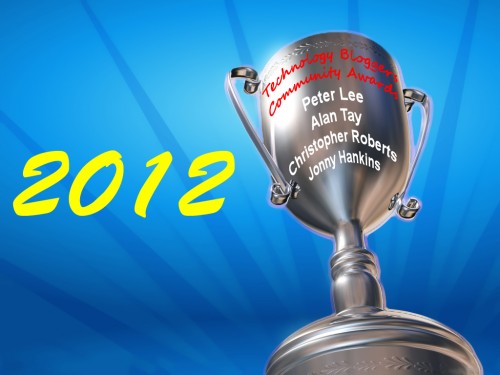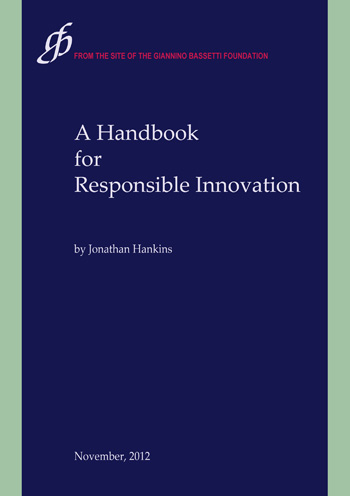Slightly later than last year (I was on holiday in Italy over New Year this year), I am now going to announce the winners of Technology Bloggers community awards!
This is the second year of community awards, and this year, the awards were democratic. I gave you (the community), the opportunity to suggest awards and nominations, and then you voted on who you wanted to win each of the six awards.
This year each award had 4 nominees, meaning that there were 24 nominations; which were filled by 13 different people.
You have voted, and the results are now in. Here are this years winners.
Top Commenter
Nominees:
- Lillie Ammann
- Peter Lee
- David Jamieson
- Neil Duncan
Runner Up
![]() The runner up for this years top commenter community award is Lillie Ammann! Congratulations for Lillie for her nomination, she doesn’t comment very often but when she does, it is always kind words and useful feedback 🙂 You can find out more about Lillie by visiting her blog.
The runner up for this years top commenter community award is Lillie Ammann! Congratulations for Lillie for her nomination, she doesn’t comment very often but when she does, it is always kind words and useful feedback 🙂 You can find out more about Lillie by visiting her blog.
Winner
![]() With 57% of the vote, the clear winner of this years top commenter award is Peter Lee! My thanks go out to Peter for his fantastic contribution to the blog. Peter commented on the blog around 60 times in 2012, which is quite a lot! Never were his comments bland or meaningless though, they always added value to the article, which is a credit to Peter and the community. Peter has a website which you can visit called Computer How To Guide.
With 57% of the vote, the clear winner of this years top commenter award is Peter Lee! My thanks go out to Peter for his fantastic contribution to the blog. Peter commented on the blog around 60 times in 2012, which is quite a lot! Never were his comments bland or meaningless though, they always added value to the article, which is a credit to Peter and the community. Peter has a website which you can visit called Computer How To Guide.
Top Writer (Contributor)
Nominees:
- Alan Tay
- Hayley Anderson
- Nick Sotos
- Chadrack Irobogo
Runner Up
![]() Hayley Anderson took 29% of the community vote, putting her in second place. Hayley likes to write about nanotechnology, a very interesting industry which is advancing all the time. Hayley maintains a website herself, which is about Microscopes.
Hayley Anderson took 29% of the community vote, putting her in second place. Hayley likes to write about nanotechnology, a very interesting industry which is advancing all the time. Hayley maintains a website herself, which is about Microscopes.
Winner
![]() The winner of the top contributor category of the community awards 2012 is Alan Tay! So far Alan has contributed 7 articles to the blog, and displays many of the characteristics of a good writer. Alan often replies to people who comment on his articles, and generally writes thoughtful and useful material. Alan is a specialist in IT Security, which he blogs about on his own site too.
The winner of the top contributor category of the community awards 2012 is Alan Tay! So far Alan has contributed 7 articles to the blog, and displays many of the characteristics of a good writer. Alan often replies to people who comment on his articles, and generally writes thoughtful and useful material. Alan is a specialist in IT Security, which he blogs about on his own site too.
Top Writer (Author+)
Nominees:
- Christopher Roberts
- Jonny Hankins
- Steve August
- Ron Fletcher
Runner Up
![]() In a very respectable second place is Jonny Hankins. Author and innovation and responsibility researcher for the Bassetti Foundation, who currently resides in Boston (USA), Jonny has been a great author this year. His posts have inspired, amazed and amused, making him a true credit to the blog. Check out more of his work by visiting the Bassetti Foundation website.
In a very respectable second place is Jonny Hankins. Author and innovation and responsibility researcher for the Bassetti Foundation, who currently resides in Boston (USA), Jonny has been a great author this year. His posts have inspired, amazed and amused, making him a true credit to the blog. Check out more of his work by visiting the Bassetti Foundation website.
Winner
![]() It is with the utmost pride that I announce that the winner of the top author award 2012 is me – Christopher Roberts! It was a close fought contest between me and Jonny and myself, with 37.5% and 62.5% of the vote respectively – I am honoured to have won. Personally I feel that Jonny’s posts are often better than mine, but I shall acknowledge to the public vote and declare myself the winner. Thank you everyone 🙂
It is with the utmost pride that I announce that the winner of the top author award 2012 is me – Christopher Roberts! It was a close fought contest between me and Jonny and myself, with 37.5% and 62.5% of the vote respectively – I am honoured to have won. Personally I feel that Jonny’s posts are often better than mine, but I shall acknowledge to the public vote and declare myself the winner. Thank you everyone 🙂
Rising Star
Nominees:
- Steve August
- Jonny Hankins
- David Jamieson
- Chadrack Irobogo
Runner Up
![]() With 25% of the vote Steve August is the runner up for this award. Steve is relatively new to the community, and yet in the 5 months of 2012 that he was part of the community, he posted 7 app reviews – his preferred area of writing. Steve also contributes to Alpha Digits where you can read more of his work.
With 25% of the vote Steve August is the runner up for this award. Steve is relatively new to the community, and yet in the 5 months of 2012 that he was part of the community, he posted 7 app reviews – his preferred area of writing. Steve also contributes to Alpha Digits where you can read more of his work.
Winner
![]() 63% of the vote saw Jonny Hankins take the 2012 community award for rising star! My heartfelt congratulations go to Jonny for his fantastic contribution to the blog. With 59 posts and a series under his belt already, who knows where 2013 will take his ever progressing blogging career!
63% of the vote saw Jonny Hankins take the 2012 community award for rising star! My heartfelt congratulations go to Jonny for his fantastic contribution to the blog. With 59 posts and a series under his belt already, who knows where 2013 will take his ever progressing blogging career!
Most Friendly Member of the Community
Nominees:
- Tammi Kibler
- Peter Lee
- Lillie Ammann
- Chadrack Irobogo
Runner Up
![]() Lillie Ammann was also nominated for this category, and took 25% of the vote, making her the runner up for this award 2012. Again, well done Lillie for the nomination and votes, you are a truly valued member of the community.
Lillie Ammann was also nominated for this category, and took 25% of the vote, making her the runner up for this award 2012. Again, well done Lillie for the nomination and votes, you are a truly valued member of the community.
Winner
![]() Peter Lee took his second award this year by winning the most friendly member of the community award. Huge congratulations to Peter, as willing two awards is quite something! I look forward to your participation in 2013 🙂
Peter Lee took his second award this year by winning the most friendly member of the community award. Huge congratulations to Peter, as willing two awards is quite something! I look forward to your participation in 2013 🙂
Top All Rounder
Nominees:
- Christopher Roberts
- Jonny Hankins
- Alan Tay
- Chadrack Irobogo
Runner Up
![]() Now for the big one, the top all rounder. In the past I have referred to this as “Technology Bloggers ultimate award” as it is for someone who is an example an outstanding community member, which is why it is very deservingly that Jonny Hankins was nominated for this award, which he claimed runner up status for. One community award and runner up for another two, not a bad 2012 Jonny!
Now for the big one, the top all rounder. In the past I have referred to this as “Technology Bloggers ultimate award” as it is for someone who is an example an outstanding community member, which is why it is very deservingly that Jonny Hankins was nominated for this award, which he claimed runner up status for. One community award and runner up for another two, not a bad 2012 Jonny!
Winner
![]() I am truly humbled to have received 91% of the vote for this award. I love this blog and the people who make it as great as it is, which is probably why I put so much time and effort into posting content, moderating comments, tweaking things and generally just doing my best to make it a fantastic site to visit. Again, I would like to thank everyone who voted for me, I am truly grateful.
I am truly humbled to have received 91% of the vote for this award. I love this blog and the people who make it as great as it is, which is probably why I put so much time and effort into posting content, moderating comments, tweaking things and generally just doing my best to make it a fantastic site to visit. Again, I would like to thank everyone who voted for me, I am truly grateful.
Well that’s 2012’s awards over, 6 categories, with 7 unique winners and runners up, democratically chosen by you: the readers of the blog.
2012 was a brilliant year for us, and our visitor numbers prove it. Here is a sneak peak at some traffic stats that I wouldn’t usually publicly release.
Happy New Year everyone, here’s to 2013!




